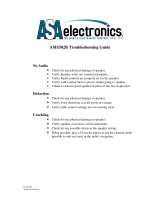
ARCHITECT
Model 1280 EQ • Model 1260
Model 1680 EQ • Model 1660
Installer’s Guide
™
5
Bus Select Switches – The switches below
each zone’s local input jacks select the input
source for that amplier zone. If the switch
is in the “Local” position, the zone receives
audio signals from the local input. If the
switch is in “Bus 1” or “Bus 2”, audio signals
come from the appropriate “Bus” inputs.
Whenever a Bus Input is selected, the zone
input can be remotely triggered to the local
input using the 12 volt Local Trigger input
(see #6 on previous page).
Local Inputs - These unbalanced RCA in-
puts connect to your preamplier’s outputs.
Any standard line level audio signal can be
connected to these inputs.
AC Power Fuse – The Architect is designed
with several layers of protection circuitry.
The main AC power fuse is here just in case
something really awful goes wrong. There
are no internal fuses in this amp.
Master Power Switch – This switch shuts
o the main AC power. Normally the only
time you need to turn the master power
switch o is if the system is going to be shut
down for an extended period of time.
Remote Power Control – This three pin
connector allows you to remotely turn on
the Architect. You can either use a contact
Guided Tour
closure between the Trigger In and the
+12V output or an external 12 volt trigger
between the Control In and Ground termi-
nals. The +12 volt output is not designed to
power other pieces of equipment.
Ground Lift Switch – This switch selects
the level of isolation between the audio
signal ground and your AC earth ground.
In normal operation this switch should be
in the Ground position, but if you run into
trouble with an AC ground hum, try the oth-
er two settings for the best operation. For
your safety, the chassis is always connected
to the earth ground regardless of the switch
setting.
Remote Power control (1/8” jacks) - These
mono 1/8” jacks are wired parallel to each
other and work in conjunction with the
3-pin remote power connector. Either 1/8”
input can receive a 12-volt trigger which
will turn-on your Architect amplier. This
will then allow the unused jack to output 12
volts that can be used to turn-on a second
amplier. If your using the 3-pin connec-
tor to trigger the Architect, both of the 1/8”
jacks can provide output trigger
15
14
13
12
11
11 12
15 14
13
13






















